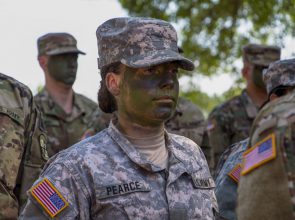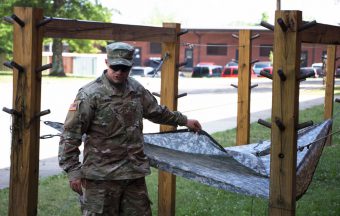FORT KNOX, Ky. — It’ll never be home, or entirely dry or clean, but when in the field, can these luxuries even be expected? Yesterday, during field craft tactic classes, 1st Regiment, Basic Camp Cadets learned basic protection from the elements.

1st Regiment, Basic Camp Cadet in full face camouflage, June 15, 2018 at Fort Knox, KY. (Photo by Angela Yin)
“If I could sum it up in a few words, it would be ‘how to be comfortable in the field and in the outdoors,’” Cadet James Iaia, Widener University surmised. “It’s not necessarily your survival skills per se.”
Properly packing a rucksack, applying convincing facial camouflage paint, and pitching a poncho lean-to, all work to fulfill each Cadet’s goal of keeping themselves and their gear usable.
These classes provide common sense answers which the Army has accumulated from years of trekking across the globe and while living in not so hospitable climates.
MS3 instructor Cadet Francesca Cervone from the University of Notre Dame explained the reasoning.

Instructor 2nd Lt. Wheat demonstrates poncho lean-to construction, June 15, 2018 at Fort Knox, KY. (Photo by Angela Yin)
When packing a rucksack, Cadets need to be aware of item weight-distribution. “That ensures they can carry their equipment for long distances,” Cervone explained. With a properly packed bag, “they’re able to go for miles.” Plus, if they mind their water-proof and water-resistant materials, their socks, underwear, shirts, and other gear can survive a march through a deep creek.
While camouflage uniforms keep the body mostly hidden, exposed skin rarely blends into the environment. Cadets learned to paint their faces, “so they can properly blend in and the enemy cannot see them,” Cervone said.

Instructor Master Sgt. Chubb shows Cadets how to pack a rucksack, June 15, 2018 at Fort Knox, KY. (Photo by Angela Yin)
Instructors also demonstrated poncho shelter construction, “so that they can sleep at night with cover and concealment,” Cervone said. “It allows them to get the best night of sleep they can, even though they are in the field.”
This shelter is one of the ways Cadets will protect themselves from harsh, heavy rains.
These short classes teach Cadets how to keep their gear manageable and themselves healthy, so they can perform those duties required of them.
“These are our survival skills when we are out in the field and encountering enemies,” Staff Sgt. Chase Lester explained. Our Soldiers should be prepared.
“If you’re not comfortable, you’re a less effective fighter,” Iaia concluded.




